SECOND AFFIDAVIT MUDDY CREEK UTAH 2019
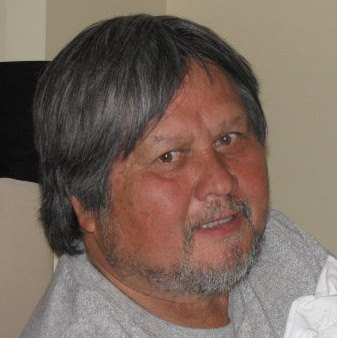
Former USDA Veterinarian and Whistle Blower
WHOA Board Member
I, Dr. Lester Friedlander DVM BA of Bradford County Pennsylvania do, hereby state that the facts above set forth are true and correct (or are true and correct to the best of my knowledge, information and belief) and that I expect to be able to prove the same at a hearing held in this matter. I understand that the statements herein are made subject to the penalties of 18 Pa.C.S. § 4904 (relating to unsworn falsification to authorities).
Date: 4/3/2019
¦ Signature: REDACTED
I am the president of Citizens Against Equine Slaughter (CAES) a national 501c3 non-profit based in Oregon.
In this affidavit, I re-assert everything I stated in my previous affidavit/s for this Muddy Creek HMA.
As I stated: Only the Secretary of the Interior can authorize a round up by helicopter as clearly, this is a very dangerous situation for the wild horses. However, there is no legal right to condone extreme animal cruelty, harassment and death as wild horses are not livestock.
In my previous affidavit I outlined many of the atrocities of helicopter round ups and alternatives.
BLM has two veterinary groups and the Inspector General observe from afar, helicopter round -ups in an effort to have them declared humane. (See foot notes 10,11,12 on pg 25 of BLM Response)
Now the BLM comes and states that two groups of veterinarians and the inspector General have studied and or declared that helicopter round ups are humane (without an actual study) and that they are necessary. However, this is wholly unreasonable without an actual study.
Again, there are alternatives for on range management as called for by these veterinarians as well as proof that the gather and removal off the range is not working, per these reports, the in state of Utah alone over 15,000 horses have already been gathered. This amount of gathers, handling, and feeding is astounding versus the ease that the originating horses could be simply darted on the range with nowhere near the amount of cost, time, harassment, and cruelty as recommended by the National Academy of Sciences.
These Veterinarians have also recommended that helicopter usage include wide angle cameras for study and documentation as has CAES repeatedly for years. This would also handle handicap access.
Simple lure traps around water sources would suffice for simple on the ground darting or darting from helicopter one family at a time. If people can go out to these places to manage their cattle, why cannot we go out to the horses and lure trap for darting and release? An example is shown in my previous Affidavit of the lure traps at the Soccorro BLM in NM.
The Inspector General states that the National Academy of Sciences should be followed as the best science however does not follow through. Excuses given that logistics are different than Assateague a 45,000 acre island. However, it is easier to design logistics at places that are not surrounded by water.
However, this field office, this agency, and this government are essentially blocking the best alternative as recommended by the National Academy of Sciences. Be that as it may, this Secretary of State has no legal right to act inhumanely against both the 1971 Act, the animal cruelty laws of the states and the nation .
No Veterinarian has even sat in a helicopter during any round up in these three studies.
In the BLM Response to Appellees Statement of Reasons, though the BLM makes the claim that Veterinarians have studied helicopter round ups, no Veterinarian has even sat in a helicopter during a helicopter round up. They have only sat at the capture shute areas as do other citizens. The 4 independent Veterinarians did actually go for a ride in a helicopter over a number of HMAs, but not during a round-up.
There have been no Scientific or Veterinary Study of helicopter round ups and the associated issues such as Post Capture Myopathy Syndrome or Rhabdomyolysis. (See Attachments 1, 2)
Short List of Issues
Here is a short list of the issues with the two Veterinary Studies of APHA and AAEP of 2010 foot notes 10 and 12 respectively. Both show some serious effects of helicopter round ups as well which illustrate that these are inhumane and do not include the first 5 to 6 miles of wild horses falling out prior to the gather shuts.
The fact that they did these two Veterinary Studies lets us know that they themselves know that there should be a study and that treating wild horses in this manner is indeed extreme animal cruelty on all levels and these studies are little more than a cover up albeit with a few decent recommendations, though the BLM did not implement them.
- Eleven Vets of the AAEP which are not without a conflict of interest. They are the founding member of the unwanted horse coalition which is comprised in part by pro-horse slaughter members. Their names are not even included in the study. Their questionnaires were not even included in the study.
- No AAEP Veterinarian rode/flew in a helicopter during a round-up, which are easily 5 miles.
- There were no cameras on the helicopters monitoring and documenting what was happening during the round ups in the 5 -7 mile or so stampedes.
- There was no statistical study showing previous vs post conditions by age, by gender, by pregnant or not pregnant, by body score, etc.
- There was no statistical study showing White Muscle disease by distance run, number of horses run, age. There was no one on the ground to study and or follow-up with any horses which fell out.
- There was no selection process of only heathy adults male or female, or random selection process with results tabulated.
- There is no hypothesis.
- No peer review.
- There is no alternative or control studied.
The BLM has not implemented the AAEP recommendations underlined below as well as those of the APHA or the Inspector General.
Here are the recommendations of 10 AAEP Veterinarians. Page
American Association of Equine Practitoners
Bureau of Land Management (BLM)
Wild Horse and Burro Program
BLM Task Force Report
August 2011
HORSES ON THE RANGE
The BLM should utilize the best science available to obtain accurate herd management area census information in order to determine the healthy sustainable equid numbers for each area.
The BLM should prioritize research and application of effective methods to reduce the foaling rate in wild herds.
WILD HORSE GATHERS
The contract helicopter pilots should always maintain a safe distance between the helicopter and any horses that are being gathered, and between the helicopter and the ground.
The capture pens should be constructed so that pen configurations include wider sections
instead of narrow lanes for temporary holding of animals that have just been captured. This
configuration gives passive animals a circular escape from aggressive animals.
The trap should be constructed with solid side panels in the final capture pen to prevent
horses from getting their heads or legs outside of the pen and to discourage horses from
attempting to climb out of the enclosure
The use of existing barb wire fence as a stage for a jute wing should be discouraged. If barb wire fence must be used, any areas where the horses will be actively driven should be covered with jute to prevent injury.
RECORDS
The task force encourages current efforts to produce a centralized database to track the history of all horses in the BLM program. The records should include positive or negative trends in adoption programs and socially productive programs like those in place at certain prisons.
Again, The BLM has not implemented any of the above underlined recommendations. To wit, no census at Muddy Creek, only estimates from previous estimates, and the Muddy Creek Field office rounded up 153 wild horses and released 2 with birth control. This is an insult to science and to the wild horses and the American public.
In this Muddy Creek census analysis there was no census. According to the BLM Response here is how the number of horses was estimated:
Page 3,4 of the BLM Response excerpt:
As of March 1, 2018, the BLM-estimated population of wild horses within the Muddy
Creek HMA was 195, and BLM projected that the population would reach 224 horses by the end of the summer of 2018. EA at 000166, Table l. BLM based its population projection on
adding a 15% foal increase for 2017 and 2018 to the April 2017 population survey estimate.
Id.,
see also EA Appendix C. These wild horse population projections and BLM monitoring data
reflecting deteriorating range conditions led BLM to determine that excess horses existed within the Muddy Creek HMA and that excess horses needed to be removed in order to restore a thriving natural ecological balance, maintain multiple-use relationships, and prevent further degradation of rangeland resources resulting from the overpopulation of wild horses.
(However Note) This monitoring data is on file within the BLM Price Field Office. It is not in the hands of the public.
Likely Exertional Rhabdomyolysis (White Muscle Disease not communicable
The AAEP Report also gave evidence that this helicopter gather process was unnatural and fatal to wild horses. See Excerpt below on pg. 25. This showed evidence of Capture Myopathy but no recommendation was made to study the humanity of the helicopter round up exertion or to condemn this process in favor of humane and feasible alternative of dartable contraception (PZP) rather than Gona Con which is hormonal and is not dartable.
Condition of the horses after the gather: The condition of the horses immediately after capture was judged to be good, with the exception of the one horse that collapsed and died right before entering the trap. There was no sign of exhaustion or medical compromise in the other horses that were observed being gathered. The gathered horses had elevated respiratory rates as expected for any exercised horse, and some had mild to moderate body coat sweat which was dependent on the weather and distance traveled.?
APHA Main Recommendations – Group of 4 Independent Veterinarian
(From Foot note 10 on pg 25 of BLM Response) Excerpts below with emphasis added.
Independent Designated Observer Pilot Program
FINAL REPORT
October 2010 Overview One of the American Horse Protection Associations missions is the protection and preservation of Americas wild horses and burros on US public rangelands. The Bureau of Land Managements has the authority and responsibility to ensure, to its best ability, the welfare of wild horses and burros during the gather, holding, and transporting process when horses are removed from public rangeland.
Consider installing camera monitors in the chutes/corrals at short term holding facilities or trap sites for the public to observe gathering, loading, unloading and preparation of animals. The public could watch at the short term holding facilities and not be additionally stressful to the animals.
Consider mounting a wide-angle lens camera on the helicopter during gather to record movement and behavior of the horses to study the effects of the helicopter on the horses.
In line with BLMs ongoing development of its animal welfare program, in June 2010, AHPA offered to initiate a Pilot Independent Designated Observer Program Pilot Program that involved the observation and reporting on the care and handling of wild horses and burros during the gather process at three major summer gathers: Owyhee HMA (NV); Stinking Waters HMA (OR); and Twin Peaks HMA (CA). It is important to note that the Pilot Program was not intended to replace public observation days. Additionally, the Pilot Program was specific to the care and handling of the animals only. BLM policy regarding removals was not within the scope of the Pilot Program.
Horses travelled an average of 5-7 miles to trap site, and a Judas (or Prada) horse was utilized. Most horses entered the trap at a trot, some at a canter.
At the Stinking Water gather, a 23 year old stallion jumped out of the pen and escaped the trap site. About ½ mile from trap, he was subsequently roped and his legs were tied while in a recumbent position, and eventually was transported in a two compartment stock horse trailer back to the Burns Corrals.
At the Owyhee gather, horses were observed to be tucked up suggesting decreased water intake. Some foals had mud on their faces, suggesting they had been trying to suck water because their dams were not producing sufficient milk, and willingly drank water from a bucket which is uncommon and implies tremendous thirst.
Hoof condition was generally good with no significant defects. One foal at the Stinking Water gather had noticeable chipping in one hoof but was not lame.
Coat/hide condition was generally good and clean, and indicative of the summer season.
Lameness: One mare at the Bull Flats temporary holding facility (Twin Peaks gather) was grade 3 lame at the trot, with no visible lesions. At the Litchfield short term holding facility two foals were observed to be stiff and foot sore but mobile. One stallion at the Owyhee gather came in lame with an old knee injury.
Injuries: One mare with pre-existing injury to hind leg at the Twin Peaks gather; superficial scrapes/kick wounds and one ~4 inch laceration which was sutured by the APHIS veterinarian in the squeeze chute at the Stinking Water gather; cuts and scrapes were noted at the Owyhee gather and were most often treated with a furazone type product. Illness: A few horses exhibited colicky signs at the Owyhee gather; one mare was observed to have symptoms of rhabdomyolysis at the Stinking Water gather.
Recommendations Based on the observations of the 4 independent designated observers, the following recommendations are offered for consideration:
If at all possible, horses should not be roped or tied down in a recumbent position for prolonged periods of time, especially coinciding with exhaustive or over-heated conditions. Strict criteria should be established to determine the initiation and purpose of this practice. If necessary to implement these procedures, these horses should be identified, marked, and/or confined separately from the others in the gather and observed for any injuries or metabolic conditions for the next 48 hours. This could be achieved by moving these animals to designated, smaller holding corrals.
Excessively aggressive horses (studs or mares) should be isolated as soon as possible or grouped with horses they were with before capture (i.e., a harem stallion with his foals or dry mares) rather than stand waiting in the chutes or alleyways.
Horses held in any enclosure over 4 hours after the gather at the trap site should be provided with access to hay and water in at least 100 gallon containers unless the horses are seriously dehydrated or compromised and, in the opinion of a veterinarian, should have restricted access to reduce the risk of water intoxication. Lidocaine spray (or other topical anesthetic) should be utilized by attending veterinarians in order to facilitate suturing of wounds in horses in the squeeze chute. Transport (unloading and loading) of animals should be kept to a minimum.
Inspector General US Dept. of Interior 2011
(Foot note 11 pg. 25 BLM Response)
Like the other Veterinary Reports above, the inspector general report did not scientifically prove any of the statements regarding helicopter round ups as humane as no tests of helicopter round ups in progress were performed, only observation from the ground at the end of a 5 to 7 mile long stampede.
Recommendations
To address the issues outlined in this inspection, we recommend that BLM:
Continue moving forward with the Secretarys initiative and BLMs program
improvements to the extent that:
1. There is urgent and aggressive focus on research and testing of improved
population control methods to balance wild horse and burro population
growth with adoption demand, thereby minimizing the need for additional
long-term holding facilities and preserves.
2. There is an ambitious effort to minimize and reduce over the long term the
need for short- and long-term storage facilities.
3. The best science for wild horse and burro management and needed new
research is coordinated with and confirmed by the National Academy of
Sciences and the results put into practice.
ATTACHMENT I. Capture Myopathy intro.
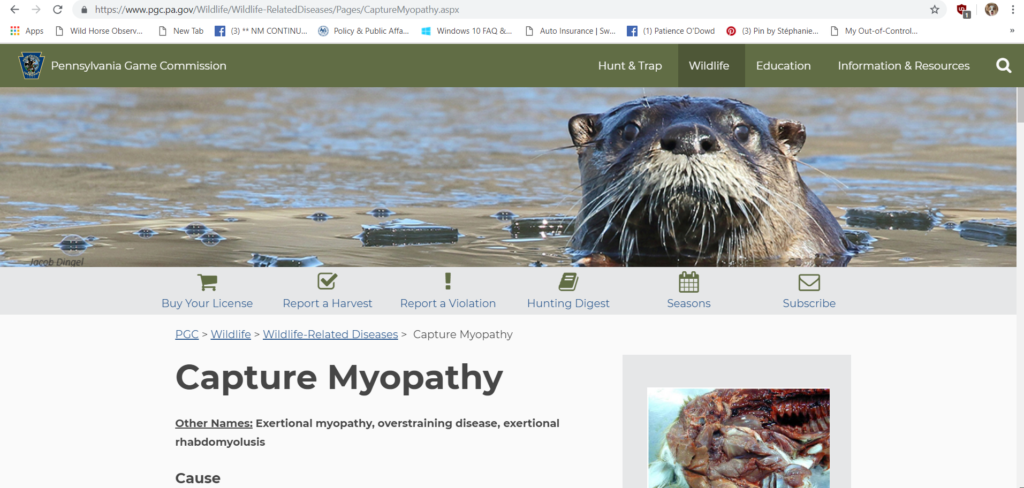
https://www.pgc.pa.gov/Wildlife/Wildlife-RelatedDiseases/Pages/CaptureMyopathy.aspx
Capture Myopathy
Other Names: Exertional myopathy, overstraining disease, exertional rhabdomyolusis
Cause
Capture myopathy (CM) is a non-infectious disease of wild and domestic animals in which muscle damage results from extreme exertion, struggle, or stress. CM often occurs as a result of chemical immobilization, capture, or transport, but it is not always associated with capture and can be the result of other causes of stress.
Significance
Capture myopathy is an important cause of death in wild animals that are handled by humans, and people working with wildlife must take great care to prevent it.
Transmission/Disease Development
CM can occur naturally when prey animals are attempting to avoid predation, but it is usually caused by humans. This is because animals are adapted to escape from predators, but are not adapted to struggle for long periods of time in man-made restraints. Capture myopathy occurs when animals overexert themselves (struggling in a trap for example) so much that physiological imbalances develop and result in severe muscle damage. Hotter temperatures and repeated chemical immobilization increase the risk of animals suffering from CM.
Clinical Signs
Clinical signs vary depending on the species and the cause of exertion; the method of capture and restraint plays a major role in the occurrence of CM. Capture myopathy may result in sudden death, or clinical signs may develop hours, days, or up to two months following capture. Early clinical signs include elevated respiratory rate, heart rate, and body temperature. Body temperature increases during exertion and higher temperatures are often associated with death due to CM. Other clinical signs include depression, lack of response to stimuli, loss of coordination, weakness, muscle stiffness, tremors, muscle paralysis, recumbency, shock, and at times death.
Diagnosis
Light-colored skeletal and sometimes cardiac muscle observed at necropsy is indicative of capture myopathy. Similar gross lesions may be found in animals with certain nutritional deficiencies, and specialized tests may be necessary to reach a diagnosis. Gross changes in muscle appearance may not be observable in animals that died acutely of CM.
Treatment
Treatment of wildlife suffering from CM is rarely successful, and animals often die from this condition.
Management/Prevention
Everyone who captures and restrains wildlife should be aware of the risks of capture myopathy and should make every effort to prevent its occurrence. Wild animals should only be captured when necessary, and the negative affects that capture may have on an animal’s health should always be considered before beginning a management or scientific project. People should utilize capture methods that minimize animal stress, struggling, and handling time. For example, sound should be kept to a minimum, a blindfold should be placed over the animal’s eyes, and workers should be efficient so that the animal may be released as soon as possible. Appropriate methods may vary for each species, so research should be conducted in order to select the ideal capture method.
ATTACHMENT 2 Exertional Rhabdomyolysis Wild horses are flight animals and very susceptible to this disease which can go un noticed for days and be fatal.
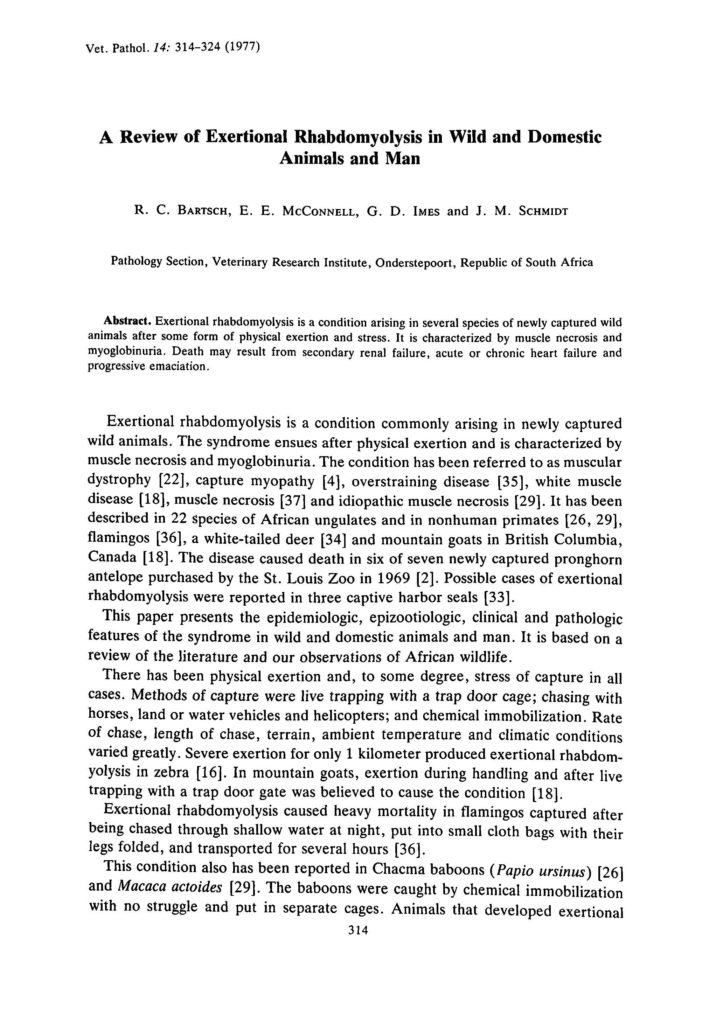
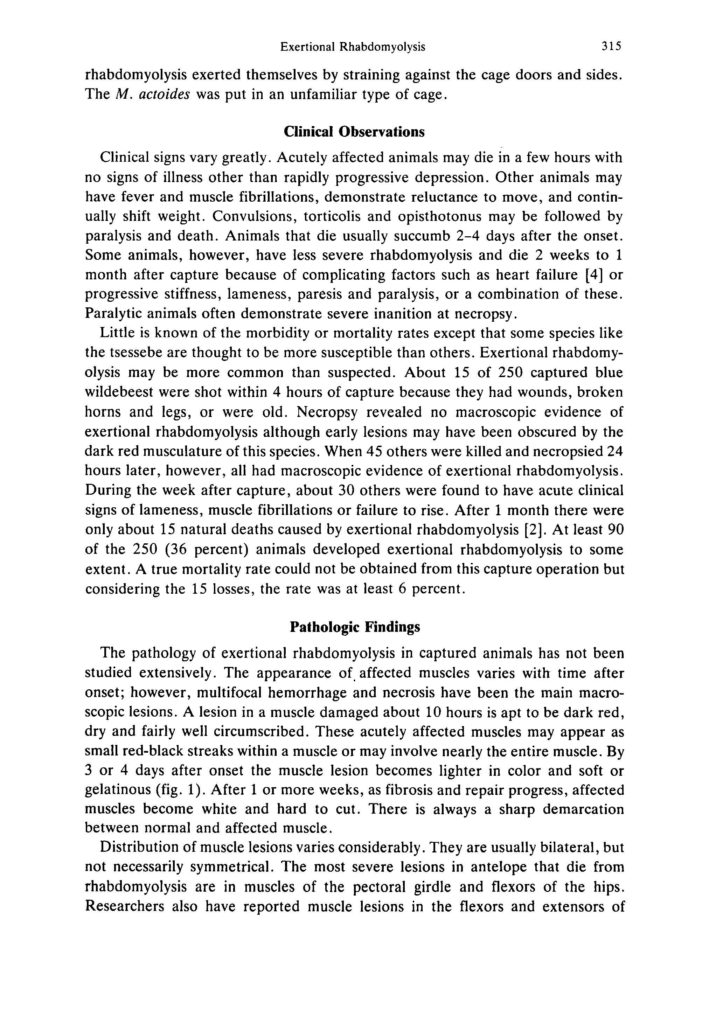
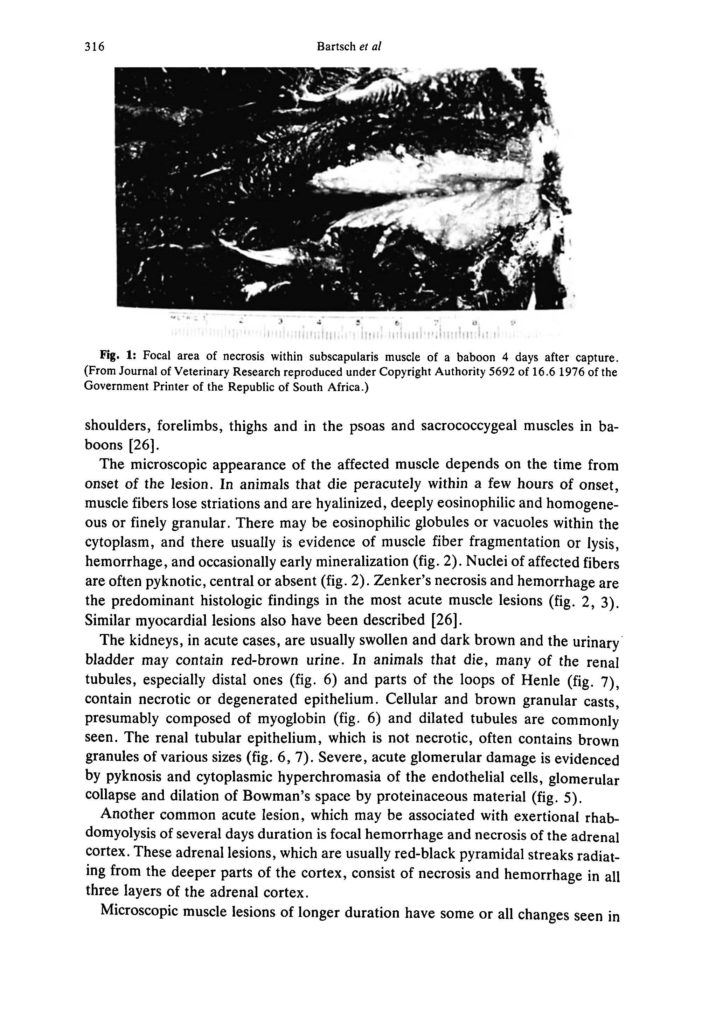
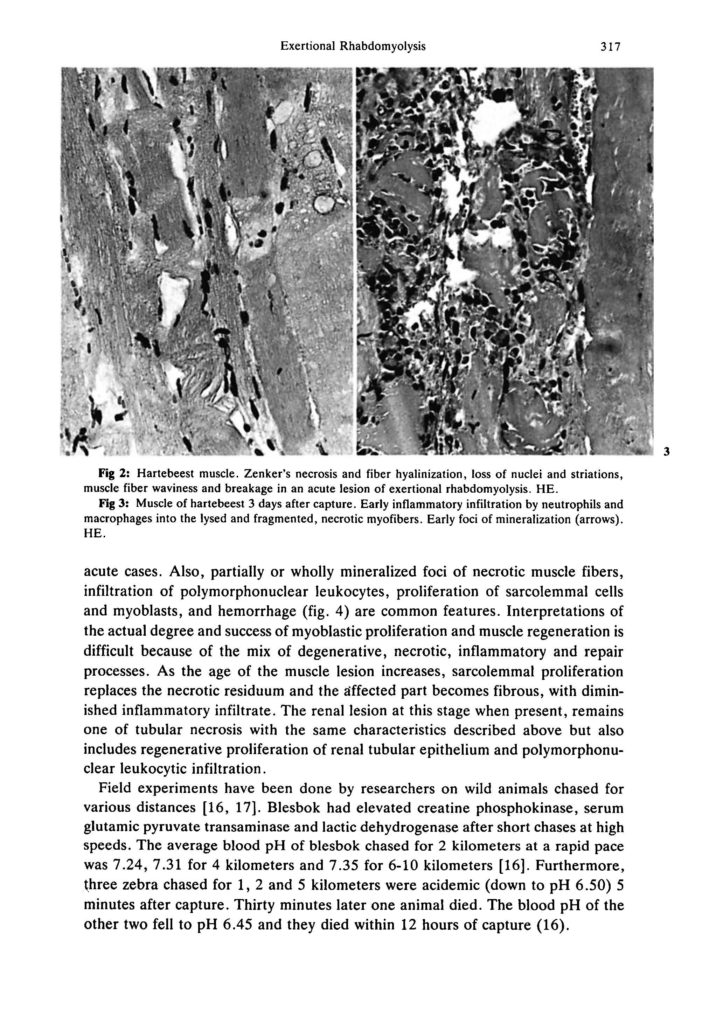
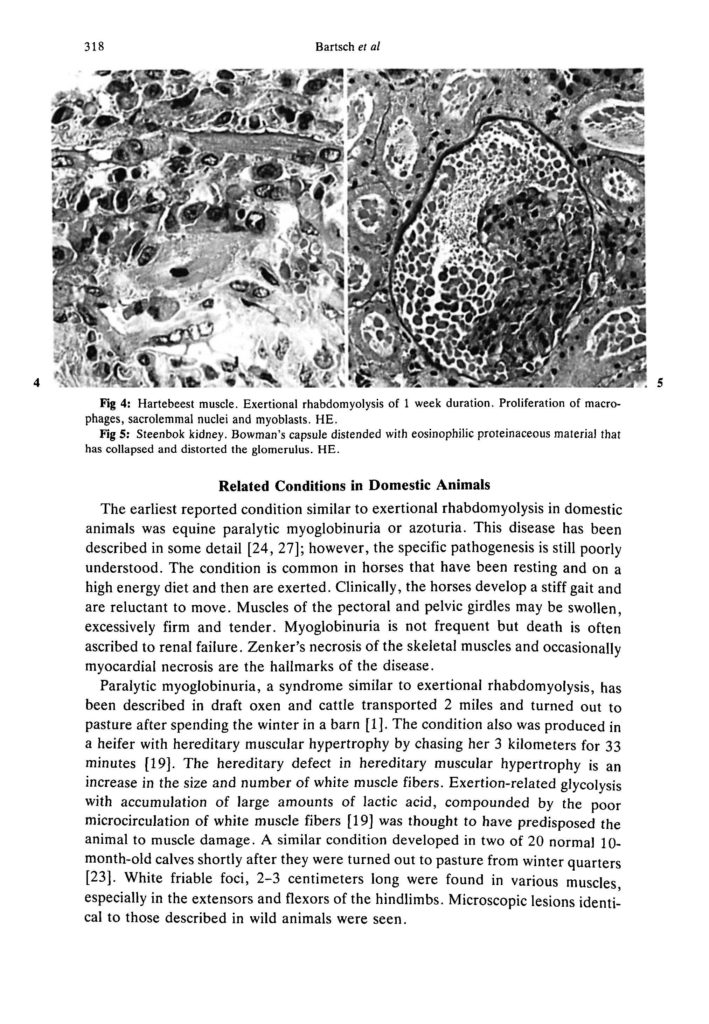
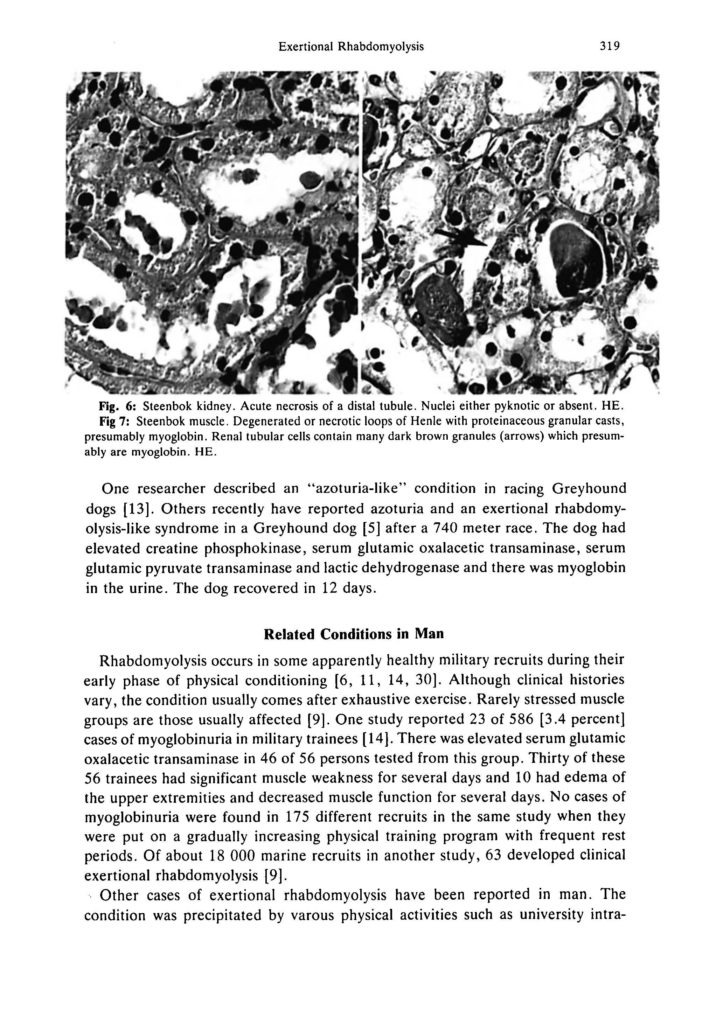
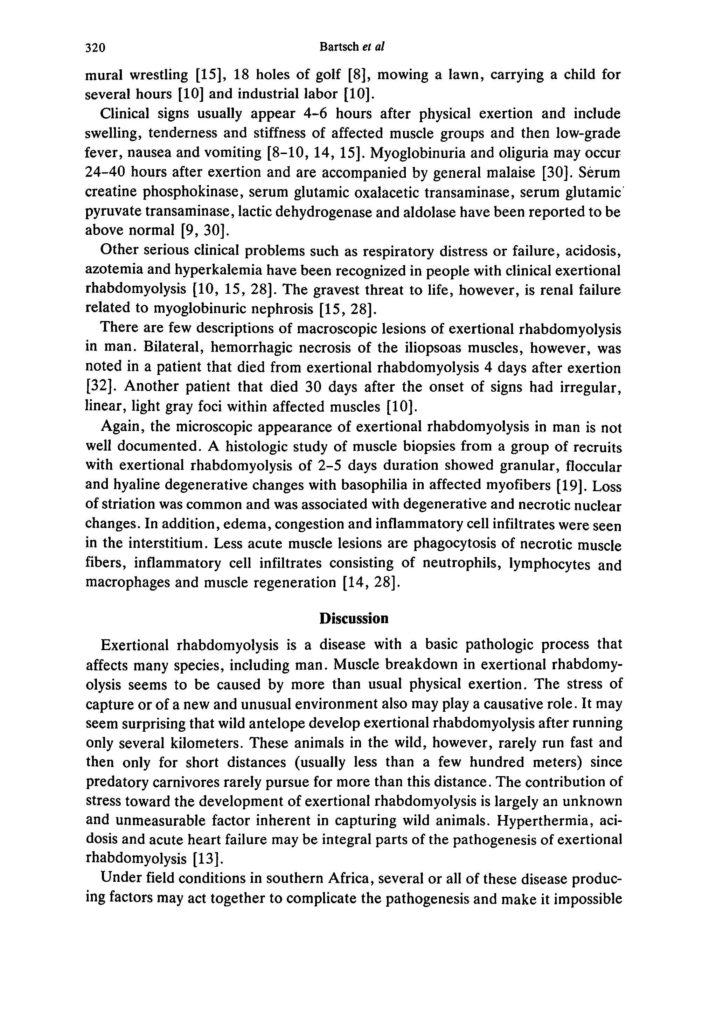
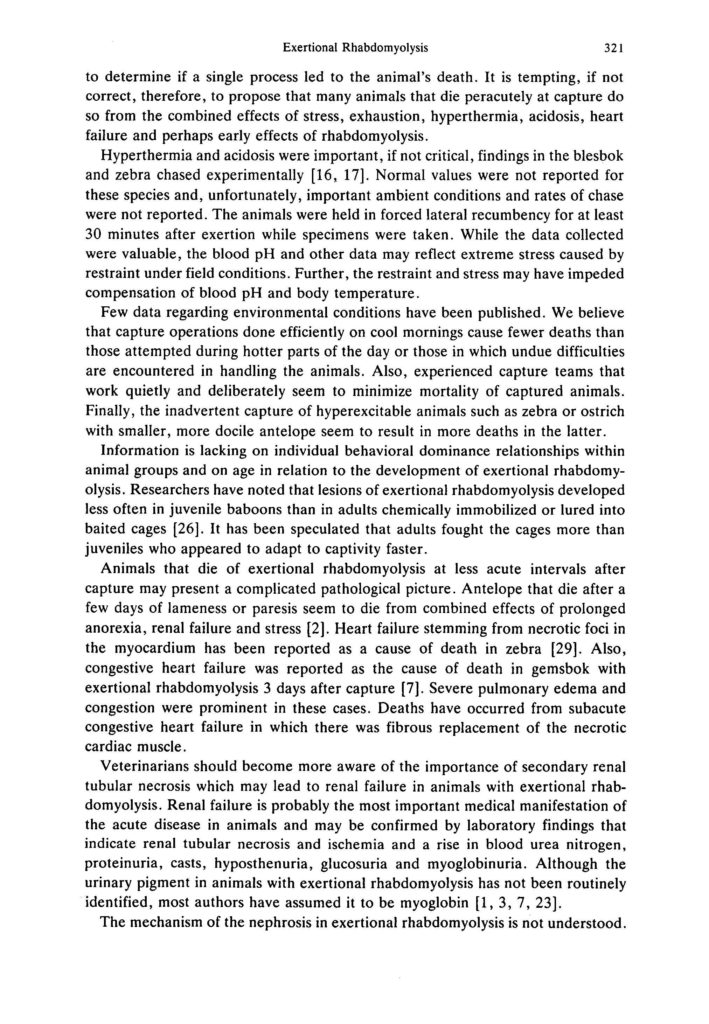
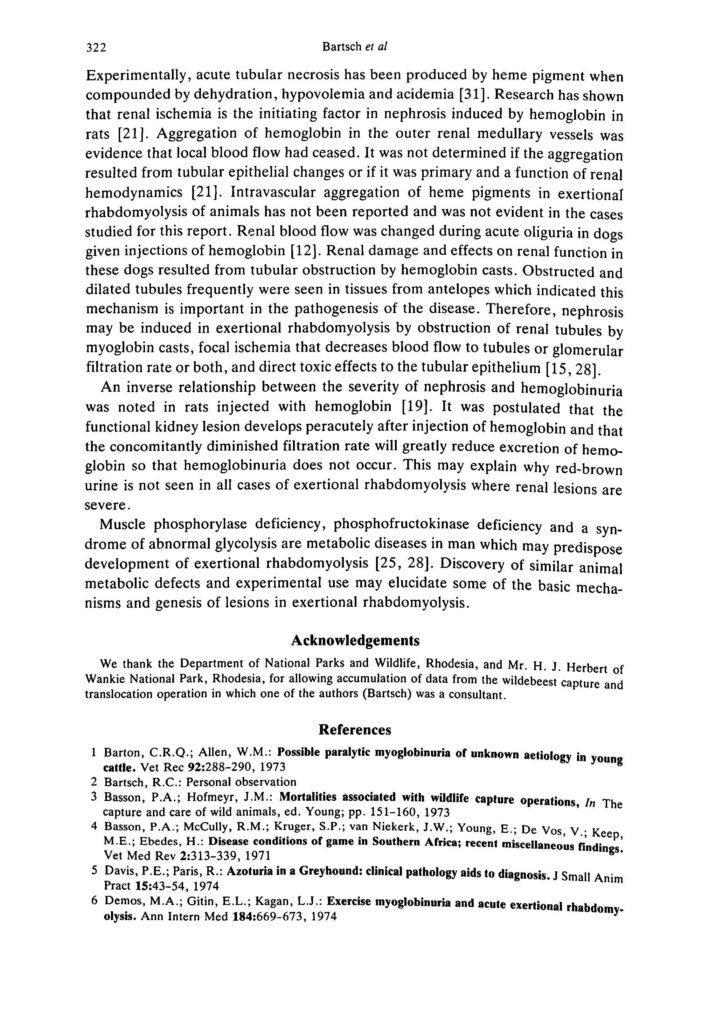
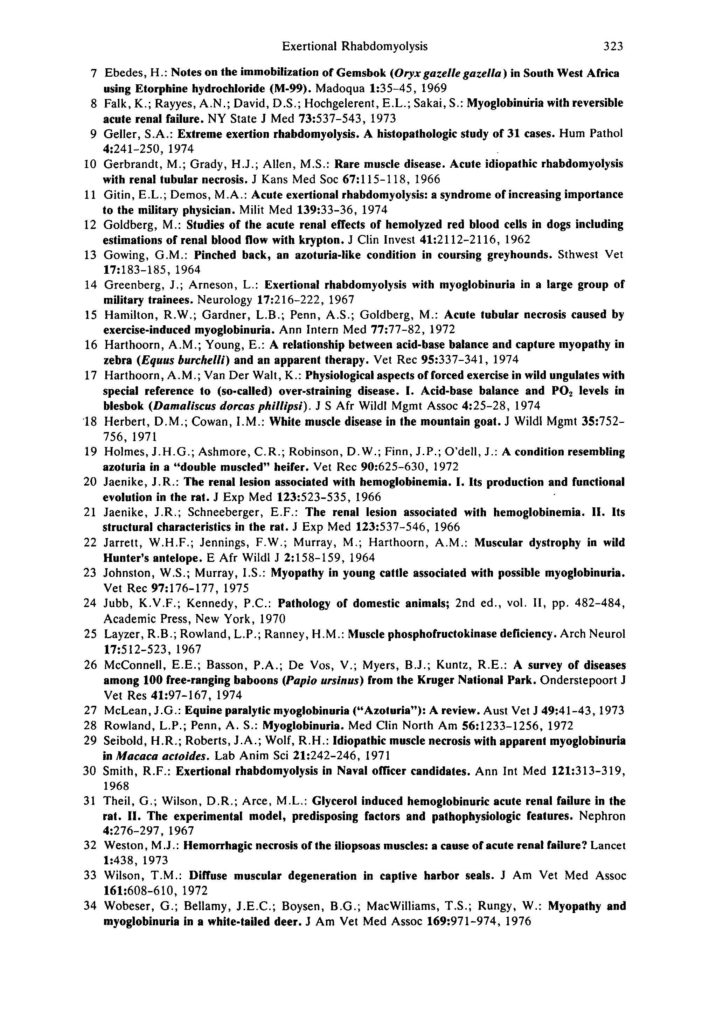
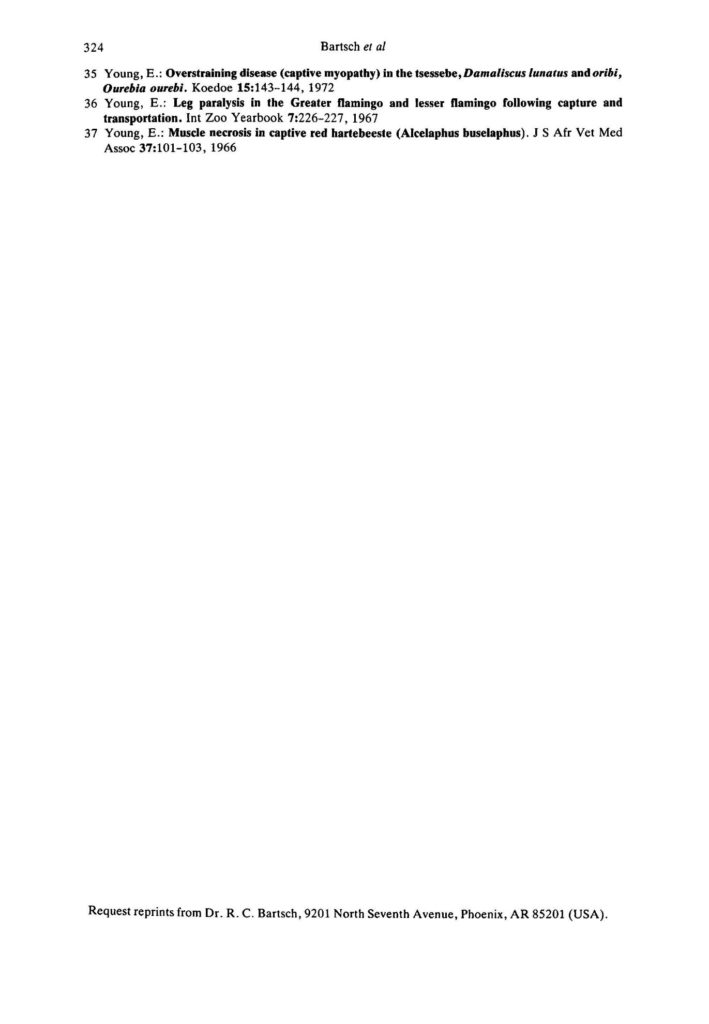
ATTACHMENT: An hour hearing cannot provide the experimentation and review necessary. Use of motorized vehicles that allows families to stay together reduces stress on the individuals and family. This hearing was not greatly advertised and I can see no follow-up.
Moreover, 4800 animals as quoted below id likely only 2,400 animals to dart. This is the creation of 5 good jobs for darting etc. rather than the helicopters, harassment, and death, and including the bird lady.
BLM TO HOST STATEWIDE PUBLIC HEARING REGARDING USE OF MOTORIZED VEHICLES AND AIRCRAFT IN THE WILD HORSE AND BURRO PROGRAM
VERNAL, Utah“ The Bureau of Land Management (BLM) will host its annual statewide public hearing at the BLM Vernal Field Office to discuss the use of helicopters and motorized vehicles in the management of wild horses and burros on Utah public lands.
The hearing will take place:
Tuesday, Dec. 11, 2018, 7 p.m.
BLM Vernal Field Office
170 S 500 E
Vernal, Utah 84078
Helicopter and motorized vehicle usage is a critical tool for managing wild horses and burros on public lands, said Gus Warr, BLM Utah Wild Horse and Burro State Lead. These management tools allow us to conduct aerial population surveys, monitor animal distribution, conduct safe and effective gathers, and transport captured animals in a humane and efficient manner.
Utahs current statewide wild horse and burro population numbers currently exceed 4,800 animals, which is more than 200 percent of the approved appropriate management level of 2,000. Having an overabundance of wild horses and burros above BLM management levels may cause resource damage resulting in limited forage and water availability, which reduces the number of animals that the land can support.
To date, the BLM has removed more than 15,600 wild horses and burros from Utahs rangelands since legislated removals began in 1976. Over 8,100 of those animals have been adopted or sold locally; the remainder were shipped outside of Utah for adoption or holding in off-range pastures. Utahs 2019 satellite adoptions start in March and continue monthly throughout the state. Adoption locations are tentatively set for Farmington, Salt Lake City, Heber City, and Delta, Utah. Animals are available for adoption on a weekly basis at the Delta Wild Horse and Burro Facility.
For additional information about the upcoming statewide public hearing, or future wild horse and burro adoptions, visit www.blm.gov or contact the Utah Wild Horse and Burro Hotline at (801) 539-4050 or Gus Warr at the BLM Utah State Office at (801) 539-4057.
Sincerely, Signature REDACTED
4/3/2019
